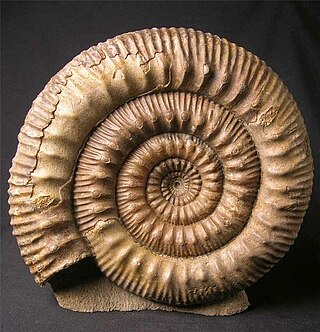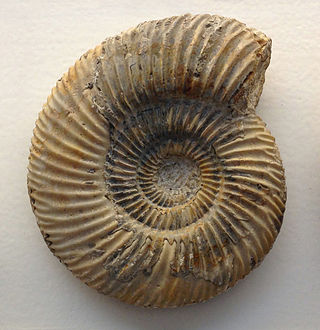In the geologic timescale, the Bajocian is an age and stage in the Middle Jurassic. It lasted from approximately 170.9 ±0.8 Ma to around 168.2 ±1.2 Ma. The Bajocian Age succeeds the Aalenian Age and precedes the Bathonian Age.
In the geologic timescale the Bathonian is an age and stage of the Middle Jurassic. It lasted from approximately 168.2 ±1.2 Ma to around 165.3 ±1.1 Ma. The Bathonian Age succeeds the Bajocian Age and precedes the Callovian Age.

Stephanoceras is an extinct genus of Stephanoceratoid ammonite which lived during the Bajocian. It is the type genus of the family Stephanoceratidae.
Abbasites is an extinct genus of ammonites from the early Middle Jurassic epoch, included in the ammonitid family Erycitidae.

Arcticoceras is an extinct ammonoid cephalopod genus from the late Middle Jurassic belonging to the ammonite family Cardioceratidae, more commonly found to high northern latitudes.
Arctocephalites is an extinct ammonitic cephalopod genus from the Middle Jurassic with a wide northern distribution belonging to the stephanoceratacean family, Cardioceratidae.

Cadomites is an extinct ammonite genus from the superfamily Stephanoceratoidea that lived during the Middle Jurassic.
Dorsetensia is a narrowly coiled discoidal ammonite from the early Middle Jurassic, lower Bajocian, belonging to the family Sonniniidae of the superfamily Hildoceratoidea. The inner whorls are ribbed or smooth, outer whorl is smooth. The outer rim (venter) is narrow, with a keel running along the middle. The umbilicus, the opening in the middle of the shell exposing inner whorls, is of moderate size with a sharp, sometimes undercut edge.

Reineckeia is an extinct genus of ammonoid cephalopods belonging to the family Reineckeiidae.

Cardioceras is an extinct ammonite genus belonging to the family Cardioceratidae. These fast-moving nektonic carnivores lived during the Jurassic period, Oxfordian age.

Parkinsoniidae is a family of ammonites belonging to the order Ammonitida. The cephalopod family lived from the Bajocian stage to the Bathonian age of the Middle Jurassic.

Parkinsonia is a genus of ammonites belonging to the family Parkinsoniidae.

Lytoceras eudesianum is an ammonite species belonging to the family Lytoceratidae. These fast-moving nektonic carnivores lived from the Bajocian age to the Bathonian age of the Middle Jurassic.

Cadoceras is an extinct ammonite genus belonging to the Cardioceratidae that lived during the Jurassic period from the late Bajocian to the early Callovian.

Skirroceras bayleanum is a Stephanoceratacean (ammonite) species belonging to the family Stephanoceratidae.

Skirroceras macrum is a Stephanoceratacean (ammonite) species belonging to the family Stephanoceratidae.
Platycrossos is an extinct genus of protocoleopteran beetles in the family Permosynidae. It is known from the Triassic and Jurassic of Australia, Austria, Mongolia and Russia. Like other members of the family, the species of this genus were described from fossils of isolated elytra with punctate striae.
This list, 2017 in paleomalacology, is a list of new taxa of ammonites and other fossil cephalopods, as well as fossil gastropods, bivalves and other molluscs that are scheduled to be described during the year 2017, as well as other significant discoveries and events related to molluscan paleontology that are scheduled to occur in the year 2017.
This list, 2018 in paleomalacology, is a list of new taxa of ammonites and other fossil cephalopods, as well as fossil gastropods, bivalves and other molluscs that are scheduled to be described during the year 2018, as well as other significant discoveries and events related to molluscan paleontology that are scheduled to occur in the year 2018.

Strophodus is an extinct genus of durophagous hybodont known from the Triassic to Cretaceous. It was formerly confused with Asteracanthus.












